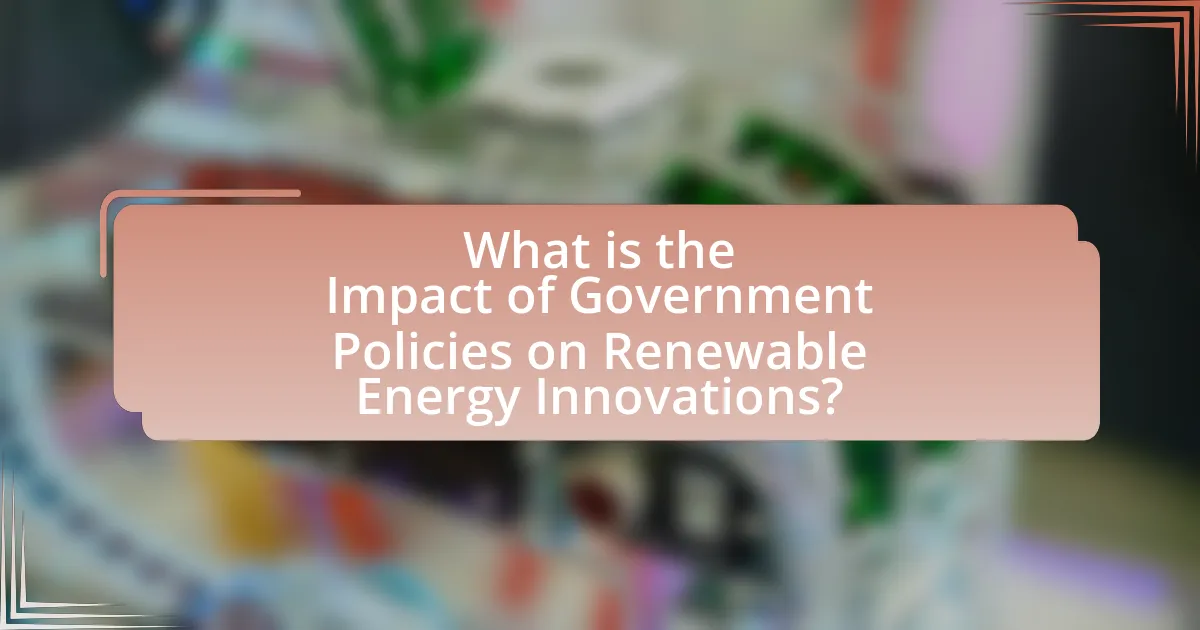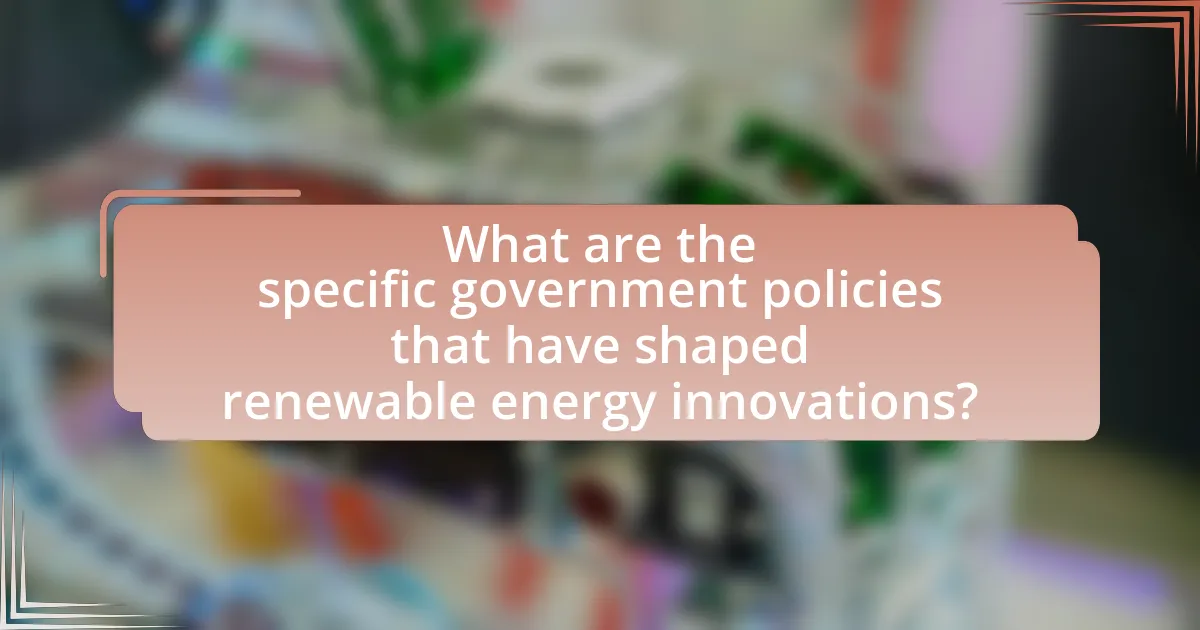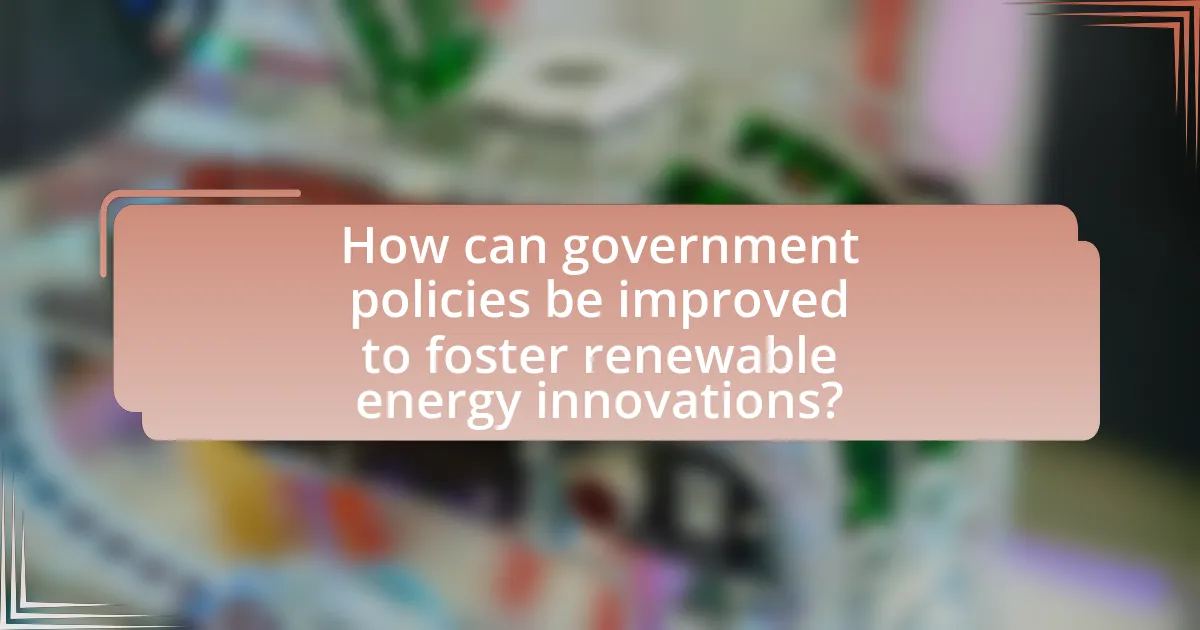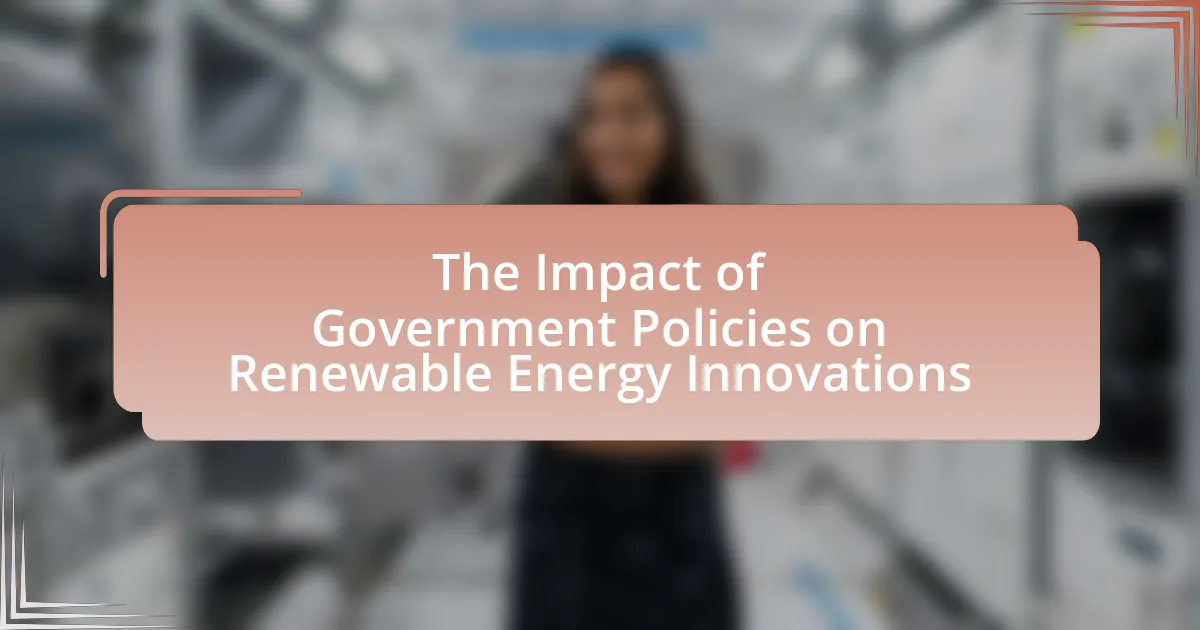The article examines the significant impact of government policies on renewable energy innovations, highlighting how financial incentives, regulatory frameworks, and research support drive advancements in this sector. It details the effectiveness of subsidies, tax credits, and regulations such as renewable portfolio standards in promoting the development and deployment of renewable technologies. The article also explores successful policy implementations in countries like Germany and Denmark, the challenges faced in policy execution, and the role of public awareness and stakeholder engagement in enhancing policy outcomes. Additionally, it discusses future trends in government policies and the influence of emerging technologies on renewable energy initiatives.

What is the Impact of Government Policies on Renewable Energy Innovations?
Government policies significantly drive renewable energy innovations by providing financial incentives, regulatory frameworks, and research support. For instance, subsidies and tax credits for solar and wind energy projects have led to a substantial increase in their deployment, with the U.S. solar capacity growing from 1.2 gigawatts in 2008 to over 100 gigawatts in 2021, largely due to supportive policies. Furthermore, regulations mandating renewable energy usage, such as renewable portfolio standards, compel utilities to invest in innovative technologies, fostering advancements in energy storage and grid integration. These policies create a conducive environment for private investment and technological development, ultimately accelerating the transition to sustainable energy sources.
How do government policies influence the development of renewable energy technologies?
Government policies significantly influence the development of renewable energy technologies by providing financial incentives, regulatory frameworks, and research funding. For instance, subsidies and tax credits for solar and wind energy projects lower the cost of investment, encouraging private sector participation. According to the International Renewable Energy Agency (IRENA), countries with supportive policies saw a 20% increase in renewable energy capacity from 2010 to 2019. Additionally, regulations such as renewable portfolio standards mandate a certain percentage of energy to come from renewable sources, driving innovation and adoption. These policies create a stable market environment, fostering technological advancements and reducing barriers to entry for new technologies.
What types of government policies are most effective in promoting renewable energy innovations?
Subsidies and tax incentives are the most effective government policies for promoting renewable energy innovations. These financial mechanisms lower the cost of renewable technologies, making them more competitive with fossil fuels. For instance, the U.S. federal Investment Tax Credit (ITC) has significantly boosted solar energy installations, leading to a 167% increase in capacity from 2016 to 2020. Additionally, feed-in tariffs guarantee fixed payments for renewable energy producers, encouraging investment and innovation in technologies like wind and solar. Countries like Germany have successfully implemented these tariffs, resulting in a substantial increase in renewable energy share from 6% in 2000 to over 40% in 2020.
How do subsidies and tax incentives affect renewable energy research and development?
Subsidies and tax incentives significantly enhance renewable energy research and development by providing financial support that lowers the cost of innovation. These financial mechanisms encourage private investment in renewable technologies, leading to increased research activities and faster development of new solutions. For instance, the U.S. federal Investment Tax Credit (ITC) has been instrumental in boosting solar energy projects, resulting in a 167% increase in solar capacity from 2010 to 2020. Additionally, subsidies can reduce the financial risks associated with research, enabling companies to pursue more ambitious projects that might otherwise be deemed too risky. This correlation between financial incentives and increased R&D is supported by studies indicating that countries with robust subsidy programs tend to lead in renewable energy advancements.
Why is government support crucial for renewable energy innovations?
Government support is crucial for renewable energy innovations because it provides essential funding, regulatory frameworks, and incentives that drive research and development. Without government backing, many renewable energy projects struggle to secure the necessary capital, as private investors often perceive them as high-risk ventures. For instance, the International Renewable Energy Agency reported that global investments in renewable energy reached $282 billion in 2019, with significant contributions from government subsidies and incentives. Additionally, government policies can create a stable market environment, encouraging companies to invest in innovative technologies, as seen in countries like Germany, where feed-in tariffs have successfully promoted solar energy adoption.
What role do regulations play in shaping renewable energy markets?
Regulations play a crucial role in shaping renewable energy markets by establishing the legal framework that governs energy production, distribution, and consumption. These regulations incentivize investment in renewable technologies through subsidies, tax credits, and renewable portfolio standards, which mandate a certain percentage of energy to come from renewable sources. For instance, the U.S. Investment Tax Credit has significantly boosted solar energy installations, leading to a 167% increase in capacity from 2016 to 2020. Additionally, regulations can facilitate market entry for new players by reducing barriers and ensuring fair competition, thus fostering innovation and driving down costs. Overall, effective regulatory frameworks are essential for promoting the growth and sustainability of renewable energy markets.
How does government funding impact the pace of innovation in renewable energy?
Government funding accelerates the pace of innovation in renewable energy by providing essential financial resources for research, development, and deployment of new technologies. This funding enables companies and research institutions to undertake high-risk projects that may not attract private investment due to uncertainty. For instance, the U.S. Department of Energy allocated over $1 billion in 2020 for renewable energy projects, which has led to advancements in solar, wind, and battery technologies. Studies indicate that countries with robust government support, such as Germany and Denmark, have seen faster adoption rates and technological breakthroughs in renewable energy sectors compared to those with limited funding.

What are the specific government policies that have shaped renewable energy innovations?
Specific government policies that have shaped renewable energy innovations include tax incentives, renewable portfolio standards, and feed-in tariffs. Tax incentives, such as the Investment Tax Credit (ITC) in the United States, have significantly boosted solar energy investments by allowing investors to deduct a percentage of the cost of solar systems from their federal taxes. Renewable portfolio standards (RPS) mandate that a certain percentage of energy must come from renewable sources, driving utilities to invest in wind and solar technologies. Feed-in tariffs guarantee fixed payments for energy produced from renewable sources, encouraging innovation and development in countries like Germany, which has seen substantial growth in solar and wind energy due to these policies.
Which countries have implemented successful renewable energy policies?
Countries that have implemented successful renewable energy policies include Germany, Denmark, and China. Germany’s Energiewende policy has led to a significant increase in renewable energy sources, with renewables accounting for over 40% of its electricity generation as of 2020. Denmark has achieved a remarkable 47% of its electricity from wind power in 2019, driven by strong government support and investment in wind energy infrastructure. China, as the world’s largest producer of solar energy, has invested heavily in renewable technologies, resulting in over 30% of its energy capacity coming from renewables by 2021. These examples demonstrate the effectiveness of targeted government policies in promoting renewable energy adoption.
What lessons can be learned from the renewable energy policies of leading countries?
Leading countries’ renewable energy policies demonstrate that strong government commitment and clear regulatory frameworks are essential for fostering innovation and investment in renewable technologies. For instance, Germany’s Energiewende policy has successfully increased renewable energy’s share in electricity generation from 6% in 2000 to over 40% in 2020, showcasing the effectiveness of long-term planning and financial incentives. Additionally, Denmark’s focus on wind energy, supported by substantial government subsidies and research funding, has made it a global leader in wind turbine technology, with wind power accounting for approximately 47% of its total electricity consumption in 2019. These examples illustrate that comprehensive policies, including financial incentives, research support, and public engagement, are critical for advancing renewable energy initiatives and achieving sustainability goals.
How do international agreements influence national renewable energy policies?
International agreements significantly influence national renewable energy policies by establishing binding commitments and frameworks that guide countries toward specific energy targets. For instance, the Paris Agreement compels signatory nations to set and achieve greenhouse gas reduction goals, which often necessitates the adoption of renewable energy sources. This global framework encourages countries to align their national policies with international standards, fostering investment in renewable technologies and facilitating knowledge sharing. Additionally, international agreements can provide financial incentives and technical support, further motivating nations to enhance their renewable energy strategies.
What challenges do governments face in implementing renewable energy policies?
Governments face significant challenges in implementing renewable energy policies, primarily due to financial constraints, regulatory hurdles, and public opposition. Financially, many governments struggle to allocate sufficient budgets for renewable projects, especially in developing countries where resources are limited. Regulatory hurdles arise from the need to navigate complex legal frameworks and coordinate with various stakeholders, which can delay project approvals and implementation. Public opposition often stems from concerns about land use, environmental impacts, and the perceived reliability of renewable energy sources. For instance, a report by the International Renewable Energy Agency in 2021 highlighted that 60% of renewable energy projects faced delays due to regulatory issues and public resistance.
How do political and economic factors affect policy effectiveness?
Political and economic factors significantly influence policy effectiveness by shaping the priorities, resources, and implementation strategies of government initiatives. For instance, political stability often leads to consistent policy frameworks, which can enhance the effectiveness of renewable energy policies by providing a clear direction for investment and innovation. Conversely, political instability can result in abrupt policy changes, undermining long-term projects and discouraging investment in renewable energy sectors.
Economically, the availability of funding and incentives directly impacts the success of renewable energy policies. Countries with robust economic conditions can allocate more resources to research and development, leading to advancements in renewable technologies. For example, Germany’s Energiewende policy, supported by strong economic backing, has successfully increased renewable energy’s share in the energy mix, demonstrating how economic factors can bolster policy effectiveness. In contrast, nations facing economic downturns may struggle to implement or sustain effective renewable energy policies due to budget constraints and reduced public investment.
What are the barriers to policy implementation in the renewable energy sector?
Barriers to policy implementation in the renewable energy sector include regulatory uncertainty, lack of financial incentives, and insufficient infrastructure. Regulatory uncertainty arises when policies are inconsistent or frequently change, making it difficult for investors to commit resources. A study by the International Renewable Energy Agency (IRENA) highlights that financial incentives, such as subsidies or tax breaks, are crucial for encouraging investment; without them, projects may not be financially viable. Additionally, inadequate infrastructure, such as limited grid capacity or outdated technology, hampers the integration of renewable energy sources into existing systems, as noted in the U.S. Department of Energy’s reports on energy transition challenges.

How can government policies be improved to foster renewable energy innovations?
Government policies can be improved to foster renewable energy innovations by increasing financial incentives for research and development. Enhanced tax credits, grants, and subsidies for renewable energy projects can stimulate investment and innovation in the sector. For instance, the U.S. government has historically utilized the Investment Tax Credit (ITC) and the Production Tax Credit (PTC) to significantly boost solar and wind energy installations, leading to a 167% increase in solar capacity from 2016 to 2020. Additionally, streamlining regulatory processes can reduce barriers for new technologies, allowing for faster deployment and commercialization. Countries like Germany have successfully implemented feed-in tariffs, guaranteeing fixed payments for renewable energy producers, which has led to substantial growth in their renewable energy market. These strategies demonstrate that targeted financial support and regulatory reform can effectively enhance innovation in renewable energy.
What best practices can be adopted for effective renewable energy policy-making?
Effective renewable energy policy-making can be achieved by adopting a multi-stakeholder approach that includes government, industry, and community input. This collaborative framework ensures that diverse perspectives are considered, leading to more comprehensive and inclusive policies. For instance, the International Renewable Energy Agency (IRENA) emphasizes the importance of stakeholder engagement in its 2021 report, which highlights that inclusive policy processes can enhance public acceptance and support for renewable energy initiatives. Additionally, establishing clear and measurable targets for renewable energy deployment, as seen in Germany’s Energiewende policy, provides a roadmap for progress and accountability. Furthermore, integrating flexible regulatory frameworks that can adapt to technological advancements and market changes is crucial, as demonstrated by the success of feed-in tariffs in various countries, which have spurred investment in renewable technologies.
How can stakeholder engagement enhance policy outcomes in renewable energy?
Stakeholder engagement can enhance policy outcomes in renewable energy by ensuring that diverse perspectives and expertise are incorporated into the decision-making process. This inclusive approach leads to more informed policies that reflect the needs and concerns of various stakeholders, including communities, businesses, and environmental groups. For instance, research by the International Renewable Energy Agency (IRENA) indicates that stakeholder involvement can improve project acceptance and reduce conflicts, ultimately leading to faster implementation of renewable energy initiatives. Engaging stakeholders also fosters collaboration, which can drive innovation and efficiency in policy execution, as evidenced by successful renewable energy projects that have actively involved local communities in planning and development.
What role does public awareness play in the success of renewable energy policies?
Public awareness is crucial for the success of renewable energy policies as it drives public support and engagement, which are essential for policy implementation. When the public is informed about the benefits of renewable energy, such as reduced greenhouse gas emissions and energy independence, they are more likely to advocate for and adopt these policies. Research indicates that countries with higher public awareness of renewable energy issues tend to have more robust policies and greater investment in renewable technologies. For instance, a study by the International Renewable Energy Agency found that public support can significantly influence government decisions on energy policy, leading to increased funding and resources allocated to renewable energy initiatives.
What future trends can be anticipated in government policies regarding renewable energy?
Future trends in government policies regarding renewable energy will likely focus on increased investment in clean technologies, stricter emissions regulations, and enhanced incentives for renewable energy adoption. Governments are expected to allocate more funding towards research and development of renewable energy sources, as evidenced by the Biden Administration’s commitment to invest $35 billion in clean energy technologies as part of the American Jobs Plan. Additionally, many countries are implementing more stringent emissions targets, such as the European Union’s goal to achieve carbon neutrality by 2050, which will drive policies that favor renewable energy over fossil fuels. Furthermore, tax credits and subsidies for solar and wind energy are anticipated to expand, similar to the extension of the Investment Tax Credit in the United States, which has significantly boosted solar energy installations. These trends indicate a clear shift towards prioritizing renewable energy in government policy frameworks.
How might emerging technologies influence future policy decisions?
Emerging technologies will significantly influence future policy decisions by providing new tools and data that can shape regulatory frameworks. For instance, advancements in artificial intelligence and big data analytics enable policymakers to better assess the impacts of renewable energy initiatives, leading to more informed and effective regulations. A study by the International Renewable Energy Agency (IRENA) highlights that data-driven decision-making can enhance the efficiency of energy systems, thereby prompting governments to adopt policies that support innovation in renewable energy technologies. This integration of technology into policy formulation ensures that regulations are adaptive and responsive to the evolving energy landscape.
What potential shifts in public opinion could impact renewable energy policy direction?
Shifts in public opinion that could impact renewable energy policy direction include increased concern over climate change, rising energy costs, and growing support for sustainable practices. For instance, a 2021 Pew Research Center survey indicated that 79% of Americans view climate change as a major threat, which can lead to stronger advocacy for renewable energy policies. Additionally, as fossil fuel prices fluctuate, public demand for more stable and affordable energy sources may drive policymakers to prioritize renewable energy initiatives. Furthermore, the increasing visibility of extreme weather events linked to climate change can galvanize public support for government action on renewable energy, influencing legislative agendas and funding allocations.
What practical steps can governments take to enhance renewable energy innovations?
Governments can enhance renewable energy innovations by implementing supportive policies, providing financial incentives, and investing in research and development. For instance, countries like Germany have successfully promoted solar energy through feed-in tariffs, which guarantee fixed payments for solar energy producers, leading to a significant increase in solar installations. Additionally, the U.S. government has utilized tax credits, such as the Investment Tax Credit (ITC), which has spurred investment in solar and wind energy projects, resulting in a 70% decrease in solar costs since 2010. Furthermore, governments can establish public-private partnerships to foster innovation, as seen in Denmark’s collaboration with private companies to develop wind energy technology, making it a global leader in wind power. These steps create a conducive environment for renewable energy advancements, driving both technological progress and market growth.


